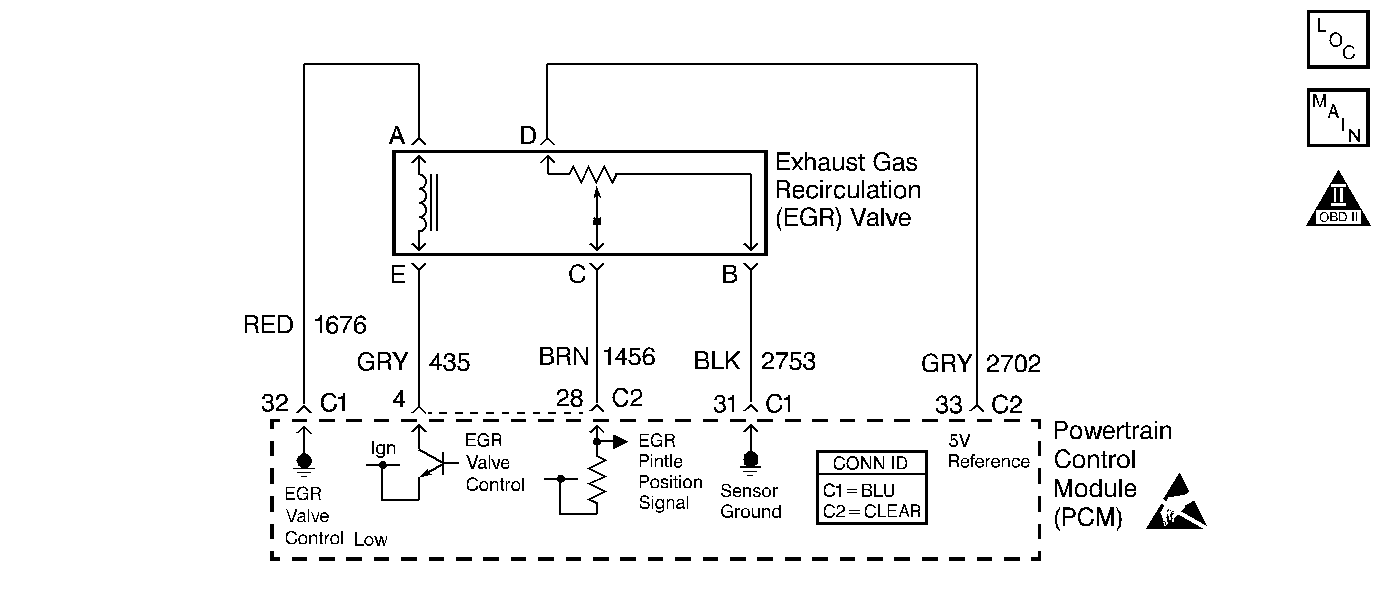
Circuit Description
The Powertrain Control Module (PCM) monitors the exhaust gas recirculation EGR valve pintle position input to ensure that the valve responds properly to commands from the PCM. When the ignition switch is turned ON, the PCM learns the EGR closed valve pintle position. The PCM compares the learned EGR closed valve pintle position to the actual EGR position when the EGR valve is commanded closed. If the actual EGR position indicates that the EGR valve is still open when the PCM is commanding the EGR valve closed, DTC P1404 will set.
Conditions for Running the DTC
| • | No TP, VSS, misfire, IAT, MAP, idle speed, fuel injector, ECT, CKP, or MAF sensor DTCs set |
| • | IAT is more than -10°C (14°F). |
| • | Engine run time is achieved--The length of time ranges from 20 seconds to 6 minutes depending upon the engine coolant temperature at startup. |
| • | TP is more than 2 percent. |
| • | Vehicle speed is more than 3.2 km/h (2 mph). |
| • | System voltage is between 10 volts and 16 volts. |
Conditions for Setting the DTC
| • | EGR feedback is 0.2 volts more than the EGR closed valve pintle position when the Desired EGR Position is commanded to 0 percent. |
| • | The above condition is present for more than 20 seconds. |
Action Taken When the DTC Sets
| • | The PCM will illuminate the malfunction indicator lamp (MIL) during the first trip in which the diagnostic runs and fails. |
| • | If equipped with traction control, the PCM will command the EBTCM via the serial data circuit to turn OFF traction control and illuminate the TRACTION OFF lamp. |
| • | The PCM will store conditions which were present when the DTC set as Freeze Frame and Fail Records data. |
Diagnostic Aids
Inspect for the following conditions:
| • | Excessive deposits on the EGR valve pintle or seat--Remove the EGR valve and check for deposits that may interfere with the EGR valve pintle extending completely or cause the pintle to stick. |
| • | Poor connections at the PCM or EGR valve--Inspect harness connectors for: |
| - | Backed out terminals |
| - | Improper mating |
| - | Broken locks |
| - | Improperly formed or damaged terminals |
| - | Poor terminal to wire connection |
| • | Damaged harness--Inspect the wiring harness for damage. If the wiring appears to be OK, connect a DMM and check the circuit continuity while moving connectors and wiring harnesses related to the EGR valve. A change in the DMM display will indicate the location of the malfunction. |
Refer to Testing for Continuity , Testing for Intermittent Conditions and Poor Connections , Repairing Connector Terminals and Connector Repairs in Wiring Systems.
Test Description
The numbers below refer to the step numbers on the diagnostic table.
-
Verifies that the malfunction is present.
-
If DTC P1404 will only set under certain conditions, the malfunction may be intermittent; refer to DTC P1404 Diagnostic Aids. If an intermittent wiring problem is not present, inspect for a poor connection at the PCM or the EGR valve. If the connections are OK and DTC P1404 continues to set, replace the EGR valve.
-
This vehicle is equipped with a PCM which utilizes an electrically erasable programmable read only memory (EEPROM). When the PCM is being replaced, the new PCM must be programmed.
Step | Action | Values | Yes | No | ||||||
|---|---|---|---|---|---|---|---|---|---|---|
1 | Did you perform the Powertrain On-Board Diagnostic (OBD) System Check? | -- | ||||||||
|
Important: : If DTC P0403 Exhaust Gas Recirculation (EGR) Solenoid Control Circuit is set, diagnose DTC P0403 first. With the engine idling, observe the Actual EGR Position display on the scan tool. Is the Actual EGR Position at the specified value? | 0% | |||||||||
3 |
Does the Desired EGR Position remain close to the Actual EGR Position at all commanded positions? | -- | ||||||||
Does the scan tool indicate DTC P1404 failed this ignition? | -- | Go to Diagnostic Aids | ||||||||
5 |
Is the Actual EGR Position at the specified value? | 0% | ||||||||
6 | Probe the EGR pintle position sensor ground circuit at the EGR valve harness connector with a test light to battery positive voltage. Is the test lamp on? | -- | ||||||||
7 |
Is the measured voltage near the specified value? | 0 V | ||||||||
8 |
Was a problem found? | -- | ||||||||
9 |
Was a problem found? | -- | ||||||||
10 | Replace the EGR valve. Refer to Exhaust Gas Recirculation Valve Replacement . Notice: If the EGR valve shows signs of excessive heat, inspect the exhaust
system for blockage--possibly a plugged converter--using the procedure
found on the Restricted Exhaust System Check. If the exhaust system is restricted,
repair the cause. Inspect for an open injector caused by one or more of the
following conditions:
Is the action complete? | -- | -- | |||||||
11 | Locate and repair short to voltage in the EGR pintle position signal circuit. Refer to Wiring Repairs in Wiring Systems. Is the action complete? | -- | -- | |||||||
12 |
Was a problem found? | -- | ||||||||
13 |
Was a problem found? | -- | ||||||||
|
Important: : The replacement PCM must be programmed. Replace the PCM. Refer to Powertrain Control Module Replacement/Programming . Is the action complete? | -- | -- | ||||||||
15 |
Does the scan tool indicate DTC P1404 failed this ignition? | -- | System OK |
